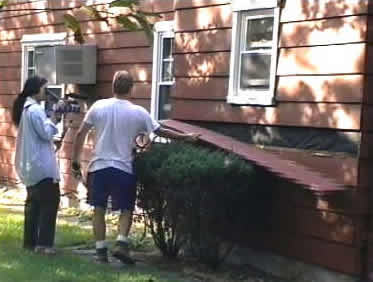home in Blue Vinyl and Libby, Montana
by Robin L. Murray and Joseph Heumann
 |  |
| Helfand films the removal of rotten wood siding from her family home. The shot establishes her presence as a character in the film. | The Blue Vinyl title shows us the completion of the new siding. |
Although many documentaries explore the devastating sense of loss residents feel when their homes are lost or destroyed by everyday eco-disasters, few examine the environmental consequences of the building materials used to construct the home. Blue Vinyl (2002) and Libby, Montana (2004) move beyond lamenting eco-driven loss of the home place found in environmental documentaries from mountaintop removal films such as B. J. Gudmundsson’s Rise Up! West Virginia (2007) and Mountain Mourning (2008)[1] [open endnotes in new window] to Josh Fox’s anti-fracking expose, Gasland (2010), and unmask some of the environmental hazards of the home itself. Although their documentary approaches differ, both Blue Vinyl and Libby, Montana reveal the toxic environmental hazards faced by workers constructing housing materials and the homeowners themselves, with Blue Vinyl focusing on the dangers of Polyvinyl Chloride, and Libby, Montana highlighting asbestos and its mineral source, vermiculite.
In the personal narrative-driven Blue Vinyl: The World’s First Toxic Comedy (2002), co-director and writer Judith Helfand and co-director/cinematographer Daniel B. Gold become comic detectives in their attempt to find a viable solution to Helfand’s parents’ home repair dilemma: Is it possible to replace rotting wood siding with “products that never hurt anyone at any point in their life cycle” but still provide the economy, endurance, and good looks of cheap but toxic blue vinyl? After attempting to convince her parents to forego their new vinyl siding choice for a more environmentally friendly alternative (as long as it’s cheap and looks good), Helfand and Gold embark on an investigative journey that reveals both the dangers underpinning vinyl use and the challenge to find a viable, affordable, and environmentally friendly alternative.
In Libby, Montana, directors Drury Gunn Carr and Doug Hawes-Davis take a more traditional documentary approach to expose the health hazards asbestos has caused in Libby’s mines and factories from 1919 until their closure in 1990. Also structured like a mystery, this social documentary combines talking head and direct cinema approaches to illuminate the biggest case of community-wide exposure to a toxic substance in U.S. history, resulting at last count in an estimated 1,500 cases of lung abnormalities. The film carefully documents the history of a town that moved from logging to mining vermiculite. Ninety-two percent of people who worked for the mine more than twenty years died from lung disease. Most condemning is evidence that W. R. Grace & Company knew the danger of asbestos and did nothing. According to the film, despite overwhelming health problems and clear signs of criminal negligence, the EPA’s arrival in 1999 leads only to more wrangling, this time over whether or not Libby should be labeled a Superfund site.
Blue Vinyl provides a narrative of discovery in which Helfand and Gold reveal what the dangers PVC mean for not only her parents and other suburbanites keen on siding their homes with vinyl, but also for PVC chemical plant workers and home dwellers nearby. Libby, Montana documents a mystery now solved but unresolved due to bureaucratic battles by EPA officials and corporate leaders over designating the town a Superfund site. In these eco-documentaries, multiple issues of home and homelessness are explored, revealing a plethora of environmental problems that, according to Blue Vinyl and Libby, Montana, especially, should be addressed no matter how difficult the task. The repercussions of doing nothing are too toxic for both human and nonhuman nature. Overlooking these eco-disasters may turn the everyday into catastrophe, these films assert, reinforcing the power of an environmental justice movement grounded in an equitable and humane vision of home.
Although the documentary strategies applied in Blue Vinyl are more compelling than those in Libby, Montana these films both effectively illustrate the complexity of environmental justice issues. Environmental injustice, lack of human rights, and, to a certain extent, environmental racism intersect in the literal study of homes in Blue Vinyl and Libby, Montana. For these films’ directors, it’s not just how you live and how you build your home, it’s where you live and what’s around you that contribute to the everyday eco-disasters associated with constructing and sustaining shelter.




































